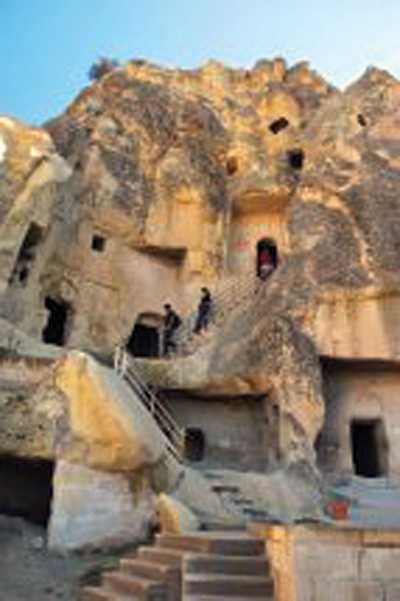By Chuck Weber
The Open Air Museum in Gorome is a UNESCO world heritage site.
When we think of lands of antiquity, two countries usually come to mind: Greece and Egypt. It is what we were taught in school regarding the land of Pharaoh’s and the cradle of democracy. The land that bridged these civilizations, Turkey, is a land that has as much history and is as much the cradle of civilization as are Greece and Egypt. She is a land of two continents, the bridge between Europe and Asia, a melting pot of cultures.

Turkey (proper pronunciation: Turkiye) abounds in archeological sites throughout the 1,000-mile by 500-mile country. Modern man has inhabited this region since the Paleolithic age dating back tens of thousands of years.
She is a land about 10 percent larger than Texas, encompassing an area of 302,000 square miles. Istanbul, Ankara (the inland capitol) and Izmir (along the Aegean coast) are the three largest cities.
The country is Muslim; however, less than a third of the population practices their faith. She is the only secular country among Muslim nations; in other words, there is separation of church and state.
One will find a very modern, Europeanized land. The country is well developed from Ankara west. East of Ankara is not as developed with locals hanging on to traditional ways but still embracing cell phones and satellite television.
The first and foremost place to visit is Istanbul, formerly Constantinople, and prior to that Byzantium. This city of 16 million is full of history pre-dating the Roman Empire.
Istanbul requires a multi-day stay if you want to see many historic sites. A minimum of three days is recommended. Cruise ships stay in port for two days.
Reminiscent of the San Francisco Bay area with busy waterways, rolling hills, suspension bridges and a beautiful skyline, the city has a unique charm.
The major attractions are the Blue Mosque, the Hippodrome, Saint Sophia, Topkapi palace and the presidential Dolmabache Palace along the waterfront. A sunset cruise under the illuminated Bosporus suspension bridge is well worth the experience.
Most impressive is Saint Sophia (Hagia Sophia) cathedral, turned mosque, turned museum. This massive structure with 10-foot thick walls and 30-foot diameter support columns with an interior dome height of 200 feet has withstood the test of time, surviving multiple major earthquakes. Built centuries ago, she is truly an engineering marvel.
For shoppers, the Grand Bazaar and the Spice Market are where you can find countless souvenirs and reasonably priced goods.
Rivaling Istanbul as a major attraction is the south central region of Cappadocia.
This region reminds one of Bryce Canyon National Park in Utah. It is an area where millennia ago, volcanic eruptions laid down a thick layer of soft ash known as pumice. Consequently, early man was able to carve dwellings into the hillsides and underground. These shelters are similar to what one finds in our American southwest.
Attractions are the UNESCO world heritage site of the Open Air Museum in Gorome, where early Christians built countless churches in the hillsides; the fairy chimneys, cone shaped structures with basalt capstones; the vast underground labyrinth city of Kaymakli; and last but not least, early morning ballooning in Gorome.
The balloon rides are not your typical two- to four-person baskets: they take 20 passengers for a 45-minute ride 1,500 feet above the picturesque countryside.
You will want to spend a minimum of three nights enjoying Cappadocia.
Ruins of antiquity: there are many, Troy, Ephesus and Perge are but a few. The Greek and Roman empires dominated this land for centuries. On our tour, we visited Ephesus, a popular cruise ship destination. Beholding these ruins leaves one awestruck by the mastery of engineering involved.
Ankara, the capitol city, has two major attractions: the Museum of Anatolian Civilizations and the Mausoleum of Ataturk, the founder of modern day Turkey.
We were in the country for only one week, enough to whet our appetites for a return visit. I would recommend a two-week tour to fully enjoy Istanbul, Cappadocia and various sites of antiquity. There is much to see, and she is well worth the visit.
Chuck Weber
Chuck Weber is with Christopher Travel, 16375 Monterey Hwy #N, Morgan Hill. Contact him at 776-7818 or e-mail [email protected].
via GilroyDispatch.com | The country of Turkey is a cradle of civilization.

Leave a Reply